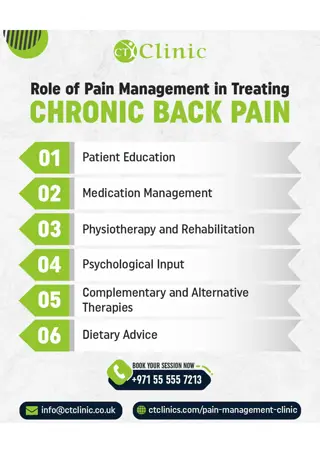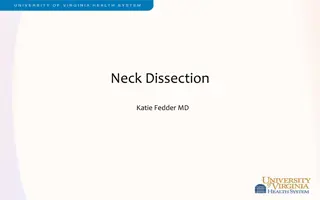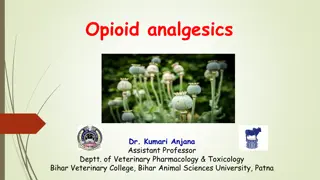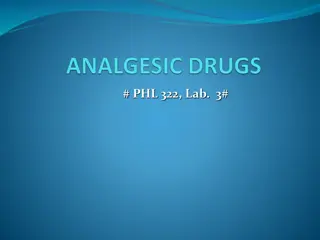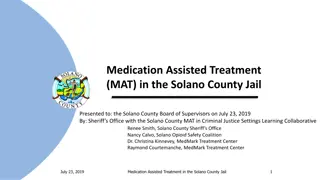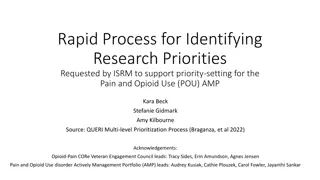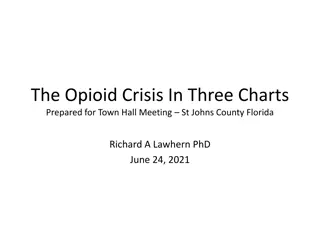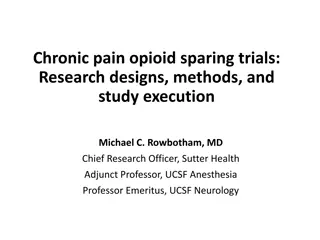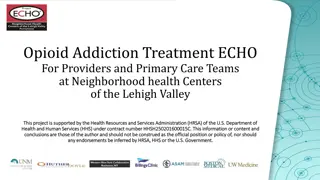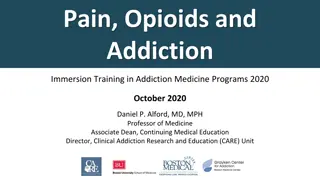Oregon Health Plan: Non-Opioid Therapies for Back and Neck Pain
The Oregon Health Plan focuses on coverage of non-opioid therapies for back and neck pain through alternative therapy implementation. Learn about the plan's initiatives, challenges, and anticipated outcomes.
Download Presentation

Please find below an Image/Link to download the presentation.
The content on the website is provided AS IS for your information and personal use only. It may not be sold, licensed, or shared on other websites without obtaining consent from the author.If you encounter any issues during the download, it is possible that the publisher has removed the file from their server.
You are allowed to download the files provided on this website for personal or commercial use, subject to the condition that they are used lawfully. All files are the property of their respective owners.
The content on the website is provided AS IS for your information and personal use only. It may not be sold, licensed, or shared on other websites without obtaining consent from the author.
E N D
Presentation Transcript
The Oregon Health Plan Coverage of Non-Opioid Therapies for Back and Neck Pain August 31, 2016 Ariel Smits, MD, MPH Medical Director Health Evidence Review Commission ariel.smits@state.or.us
Agenda Background on the Oregon Health Plan Overview of opioid misuse in Oregon New back condition care benefit changes Opioid reduction Alternative therapy implementation Anticipated outcomes Challenges encountered in implementation 2
The Oregon Health Plan Oregon Health Evidence Review Commission Comprised of volunteers from many areas of medical care, health plans, consumer representatives Regular public meetings Two products: The Prioritized List of Health Services Coverage guidances Care provided through Fee-for-Service (FFS, approx. 10% of population) and Coordinated Care Organizations (CCOs) Federal Medicaid waver 3
The Prioritized List of Health Services Purpose is to ensure coverage for the most important services in maximizing population health while controlling costs Ranks all condition/treatment pairs in priority order Funding line determined by state Legislature and approved by CMS Only conditions above the line receive coverage Guidelines help further define coverage Mental, physical and dental health merged CAM treatments available for a variety of conditions Include acupuncture, chiropractic, osteopathic manipulation, naturopathic care 4
Oregon Prescription Opioids: The Problem Opioid overdose cost to Oregon in 2014: 154 deaths 330 hospitalizations Cost of care was $9.1 million 212,000 Oregonians (5% of population) self-reported non-medical use of prescription pain relievers Back pain is the most common OHP diagnosis for opioid prescriptions Approximately 50,000 Medicaid patients with back pain diagnoses (2013 data) Approximately 30,000 received a prescription for opioids Average number of opioid prescription days for this group: 148 Approximately $5 million spent on opioids 5
Historic OHP back pain coverage (simplified) With radiculopathy Medication Surgery Chiropractic Acupuncture PT/OT Funding Line Without radiculopathy Theoretically no coverage w/o comorbidity rule. Real world: Office visits, medication, including opioids 6
2014 Back Conditions Taskforce Taskforce membership Chiropractor Acupuncturist Physical therapists Pain specialist Neurosurgeon Orthopedic surgeon Physiatrist Primary care physician Medicaid managed care plan medical director Psychologist Addictions specialist National expert in back pain treatment evidence Series of public meetings held in 2014-2015 Evidence review 2012 HERC coverage guidance, new literature reviews on surgery and opioids, expert input Changes effective July 1, 2016 7
The New Back Care Paradigm Focus on biopsychosocial model Adding evidence-based effective treatments Cognitive behavior therapy Physical therapy Chiropractic manipulation Osteopathic manipulation Acupuncture Intensive interdisciplinary rehabilitation, supervised exercise therapy, yoga and massage are recommended and may be available in some CCOs Restricting or eliminating ineffective or harmful treatments Long-term opiates no longer covered for opioid-na ve patients For patients already on long-term opioids, requirement to develop a treatment plan including alternative therapies and taper off opioids by 1/1/2018 Surgery limited to conditions with known effectiveness Epidural steroid injections removed from coverage 8
Guideline Note 56: New Treatment Pathways (Medical Treatment Line) Low Risk High Risk Office visits 4 visits PT/OT/OMT/ Chiro/Acupuncture/ massage PT/OT/OMT/ Chiro/Acupuncture/ massage Limited medications OTC meds, muscle relaxers Office visits 4 visits Cognitive Behavior Therapy Up to 30 visits PT/OT/OMT/ Chiro/Acupuncture Not OTC meds, muscle relaxers Limited opioids Recommended: 1st line opioid prescribing or long term opioid use OTC meds, muscle relaxers If available: Yoga, interdisciplinary rehab, supervised exercise, massage 9
Guideline Note 60: Opioid Medications (Coverage Criteria) During the first 6 weeks after injury, flare, surgery: Opioid use after 6 weeks, up to 90 days: Opioids after 90 days: Prescription limited to 7 days, and Short acting opioids only, and First line pharmacologic therapies are tried and ineffective, and Treatment plan includes exercise, and Opioid risk assessment Functional assessment 30% improvement With spinal manipulation, physical therapy, yoga, or acupuncture Opioid risk mitigation: - PDMP - Screen for opioid use disorder - Urine drug test Prescriptions limited to 7 days and short acting only Not Covered without new injury, flare, surgery Transitional coverage for those on long-term opioid therapy through 1/2018: Taper plan In place by January 2017 Include nonpharmacologic treatment strategies 10
Increased Coverage: - Cognitive Behavior Therapy - Spinal Manipulation - Acupuncture - PT/OT - Non-opioid medications - Yoga * - Interdisciplinary Rehab * - Supervised exercise * - Massage Therapy * * If available Decreased Coverage: - Surgeries - Opioids - Epidural Steroid Injections 11
Anticipated Outcomes Reduced opioid use for back conditions Improved public health: fewer ER visits, overdoses, deaths Improved outcomes for patients Reduced pain and better function Access to evidence-based effective care Reduced harms from opioids and ineffective surgery Better educated medical workforce Evidence based assessments and tools Improved knowledge of best practices Ultimately, reduced costs through paying only for effective care 12
Implementation Challenges Workforce for alternative therapies Example: contracting with sufficient chiropractic providers Payment challenges for some therapies Example: yoga Unable to directly bill Credentialing, CPT code issues Innovative solutions by CCOs, such as punch cards Integration of behavioral health services Low reimbursement of mental health CPT codes Provider quantity Provider knowledge about treatment of chronic pain Diagnosis coding F45.42 Pain disorder with related psychological factors 13
Implementation Challenges Continued Education of providers, patients, public Dissemination of evidence based tools Controls on narcotic prescriptions Prior authorizations FFS vs CCOs Ability to taper chronic opioid patients Availability of services for patients with opioid use disorder Possible issues with cost of care for alternative therapies 14
Next Steps New coverage implemented July 1, 2016 Feedback to HERC OHP managed health plans medical directors OHA Medicaid administrators Patients/providers Anticipate fine-tuning of Prioritized List back condition coverage and guidelines Possible work on opioid limits for non-back conditions Headache Arthritis Fibromyalgia and related conditions Neuropathic pain 15
For more information www.oregon.gov/OHA/HERC Health Evidence Review Commission HERC.Info@state.or.us 16 16


